[English] 日本語
 Yorodumi
Yorodumi- EMDB-20036: Cryo-EM structure of mouse RAG1/2 STC complex (without NBD domain) -
+ Open data
Open data
- Basic information
Basic information
| Entry | Database: EMDB / ID: EMD-20036 | |||||||||
|---|---|---|---|---|---|---|---|---|---|---|
| Title | Cryo-EM structure of mouse RAG1/2 STC complex (without NBD domain) | |||||||||
 Map data Map data | Structure of mouse RAG1/2 STC complex (without NBD domain) | |||||||||
 Sample Sample |
| |||||||||
 Keywords Keywords | V(D)J recombination / DNA Transposition / RAG / SCID / RECOMBINATION / RECOMBINATION-DNA complex | |||||||||
| Function / homology |  Function and homology information Function and homology informationmature B cell differentiation involved in immune response / B cell homeostatic proliferation / negative regulation of T cell differentiation in thymus / DN2 thymocyte differentiation / pre-B cell allelic exclusion / positive regulation of organ growth / regulation of behavioral fear response / V(D)J recombination / negative regulation of T cell apoptotic process / phosphatidylinositol-3,4-bisphosphate binding ...mature B cell differentiation involved in immune response / B cell homeostatic proliferation / negative regulation of T cell differentiation in thymus / DN2 thymocyte differentiation / pre-B cell allelic exclusion / positive regulation of organ growth / regulation of behavioral fear response / V(D)J recombination / negative regulation of T cell apoptotic process / phosphatidylinositol-3,4-bisphosphate binding / negative regulation of thymocyte apoptotic process / histone H3K4me3 reader activity / phosphatidylinositol-3,5-bisphosphate binding / regulation of T cell differentiation / organ growth / positive regulation of T cell differentiation / T cell lineage commitment / B cell lineage commitment / phosphatidylinositol-3,4,5-trisphosphate binding / T cell homeostasis / T cell differentiation / protein autoubiquitination / phosphatidylinositol-4,5-bisphosphate binding / phosphatidylinositol binding / thymus development / B cell differentiation / RING-type E3 ubiquitin transferase / visual learning / ubiquitin-protein transferase activity / ubiquitin protein ligase activity / T cell differentiation in thymus / chromatin organization / endonuclease activity / DNA recombination / histone binding / sequence-specific DNA binding / adaptive immune response / Hydrolases; Acting on ester bonds / defense response to bacterium / chromatin binding / protein homodimerization activity / DNA binding / zinc ion binding / nucleoplasm / metal ion binding / identical protein binding / nucleus Similarity search - Function | |||||||||
| Biological species |    | |||||||||
| Method | single particle reconstruction / cryo EM / Resolution: 3.06 Å | |||||||||
 Authors Authors | Chen X / Cui Y / Zhou ZH / Yang W / Gellert M | |||||||||
| Funding support |  United States, 1 items United States, 1 items
| |||||||||
 Citation Citation |  Journal: Nat Struct Mol Biol / Year: 2020 Journal: Nat Struct Mol Biol / Year: 2020Title: How mouse RAG recombinase avoids DNA transposition. Authors: Xuemin Chen / Yanxiang Cui / Huaibin Wang / Z Hong Zhou / Martin Gellert / Wei Yang /  Abstract: The RAG1-RAG2 recombinase (RAG) cleaves DNA to initiate V(D)J recombination, but RAG also belongs to the RNH-type transposase family. To learn how RAG-catalyzed transposition is inhibited in ...The RAG1-RAG2 recombinase (RAG) cleaves DNA to initiate V(D)J recombination, but RAG also belongs to the RNH-type transposase family. To learn how RAG-catalyzed transposition is inhibited in developing lymphocytes, we determined the structure of a DNA-strand transfer complex of mouse RAG at 3.1-Å resolution. The target DNA is a T form (T for transpositional target), which contains two >80° kinks towards the minor groove, only 3 bp apart. RAG2, a late evolutionary addition in V(D)J recombination, appears to enforce the sharp kinks and additional inter-segment twisting in target DNA and thus attenuates unwanted transposition. In contrast to strand transfer complexes of genuine transposases, where severe kinks occur at the integration sites of target DNA and thus prevent the reverse reaction, the sharp kink with RAG is 1 bp away from the integration site. As a result, RAG efficiently catalyzes the disintegration reaction that restores the RSS (donor) and target DNA. | |||||||||
| History |
|
- Structure visualization
Structure visualization
| Movie |
 Movie viewer Movie viewer |
|---|---|
| Structure viewer | EM map:  SurfView SurfView Molmil Molmil Jmol/JSmol Jmol/JSmol |
| Supplemental images |
- Downloads & links
Downloads & links
-EMDB archive
| Map data |  emd_20036.map.gz emd_20036.map.gz | 5.6 MB |  EMDB map data format EMDB map data format | |
|---|---|---|---|---|
| Header (meta data) |  emd-20036-v30.xml emd-20036-v30.xml emd-20036.xml emd-20036.xml | 21.3 KB 21.3 KB | Display Display |  EMDB header EMDB header |
| Images |  emd_20036.png emd_20036.png | 55.7 KB | ||
| Filedesc metadata |  emd-20036.cif.gz emd-20036.cif.gz | 8 KB | ||
| Archive directory |  http://ftp.pdbj.org/pub/emdb/structures/EMD-20036 http://ftp.pdbj.org/pub/emdb/structures/EMD-20036 ftp://ftp.pdbj.org/pub/emdb/structures/EMD-20036 ftp://ftp.pdbj.org/pub/emdb/structures/EMD-20036 | HTTPS FTP |
-Validation report
| Summary document |  emd_20036_validation.pdf.gz emd_20036_validation.pdf.gz | 360.7 KB | Display |  EMDB validaton report EMDB validaton report |
|---|---|---|---|---|
| Full document |  emd_20036_full_validation.pdf.gz emd_20036_full_validation.pdf.gz | 360.3 KB | Display | |
| Data in XML |  emd_20036_validation.xml.gz emd_20036_validation.xml.gz | 6.3 KB | Display | |
| Data in CIF |  emd_20036_validation.cif.gz emd_20036_validation.cif.gz | 7.3 KB | Display | |
| Arichive directory |  https://ftp.pdbj.org/pub/emdb/validation_reports/EMD-20036 https://ftp.pdbj.org/pub/emdb/validation_reports/EMD-20036 ftp://ftp.pdbj.org/pub/emdb/validation_reports/EMD-20036 ftp://ftp.pdbj.org/pub/emdb/validation_reports/EMD-20036 | HTTPS FTP |
-Related structure data
| Related structure data |  6oesMC  6oetC M: atomic model generated by this map C: citing same article ( |
|---|---|
| Similar structure data |
- Links
Links
| EMDB pages |  EMDB (EBI/PDBe) / EMDB (EBI/PDBe) /  EMDataResource EMDataResource |
|---|---|
| Related items in Molecule of the Month |
- Map
Map
| File |  Download / File: emd_20036.map.gz / Format: CCP4 / Size: 83.7 MB / Type: IMAGE STORED AS FLOATING POINT NUMBER (4 BYTES) Download / File: emd_20036.map.gz / Format: CCP4 / Size: 83.7 MB / Type: IMAGE STORED AS FLOATING POINT NUMBER (4 BYTES) | ||||||||||||||||||||||||||||||||||||||||||||||||||||||||||||
|---|---|---|---|---|---|---|---|---|---|---|---|---|---|---|---|---|---|---|---|---|---|---|---|---|---|---|---|---|---|---|---|---|---|---|---|---|---|---|---|---|---|---|---|---|---|---|---|---|---|---|---|---|---|---|---|---|---|---|---|---|---|
| Annotation | Structure of mouse RAG1/2 STC complex (without NBD domain) | ||||||||||||||||||||||||||||||||||||||||||||||||||||||||||||
| Projections & slices | Image control
Images are generated by Spider. | ||||||||||||||||||||||||||||||||||||||||||||||||||||||||||||
| Voxel size | X=Y=Z: 1.07 Å | ||||||||||||||||||||||||||||||||||||||||||||||||||||||||||||
| Density |
| ||||||||||||||||||||||||||||||||||||||||||||||||||||||||||||
| Symmetry | Space group: 1 | ||||||||||||||||||||||||||||||||||||||||||||||||||||||||||||
| Details | EMDB XML:
CCP4 map header:
| ||||||||||||||||||||||||||||||||||||||||||||||||||||||||||||
-Supplemental data
- Sample components
Sample components
+Entire : RAG1/2 strand transfer complex
+Supramolecule #1: RAG1/2 strand transfer complex
+Macromolecule #1: V(D)J recombination-activating protein 1
+Macromolecule #2: V(D)J recombination-activating protein 2
+Macromolecule #3: DNA (35-MER)
+Macromolecule #4: DNA (5'-D(*CP*CP*TP*GP*GP*AP*TP*CP*TP*GP*GP*CP*CP*TP*G)-3')
+Macromolecule #5: DNA (34-MER)
+Macromolecule #6: DNA (5'-D(P*CP*AP*CP*AP*GP*TP*GP*AP*TP*AP*CP*AP*GP*CP*C)-3')
+Macromolecule #7: DNA (5'-D(P*CP*AP*CP*AP*GP*TP*GP*AP*TP*GP*CP*AP*AP*A)-3')
+Macromolecule #8: CALCIUM ION
+Macromolecule #9: ZINC ION
+Macromolecule #10: water
-Experimental details
-Structure determination
| Method | cryo EM |
|---|---|
 Processing Processing | single particle reconstruction |
| Aggregation state | particle |
- Sample preparation
Sample preparation
| Buffer | pH: 7.4 |
|---|---|
| Grid | Details: unspecified |
| Vitrification | Cryogen name: ETHANE |
- Electron microscopy
Electron microscopy
| Microscope | FEI TITAN KRIOS |
|---|---|
| Image recording | Film or detector model: GATAN K2 SUMMIT (4k x 4k) / Average electron dose: 45.0 e/Å2 |
| Electron beam | Acceleration voltage: 300 kV / Electron source:  FIELD EMISSION GUN FIELD EMISSION GUN |
| Electron optics | Illumination mode: FLOOD BEAM / Imaging mode: BRIGHT FIELD |
| Experimental equipment |  Model: Titan Krios / Image courtesy: FEI Company |
 Movie
Movie Controller
Controller


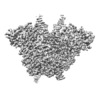








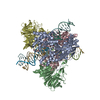
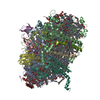
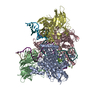
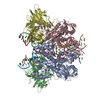

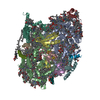
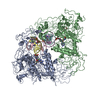

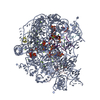







 Z (Sec.)
Z (Sec.) Y (Row.)
Y (Row.) X (Col.)
X (Col.)





















 Homo sapiens (human)
Homo sapiens (human)
